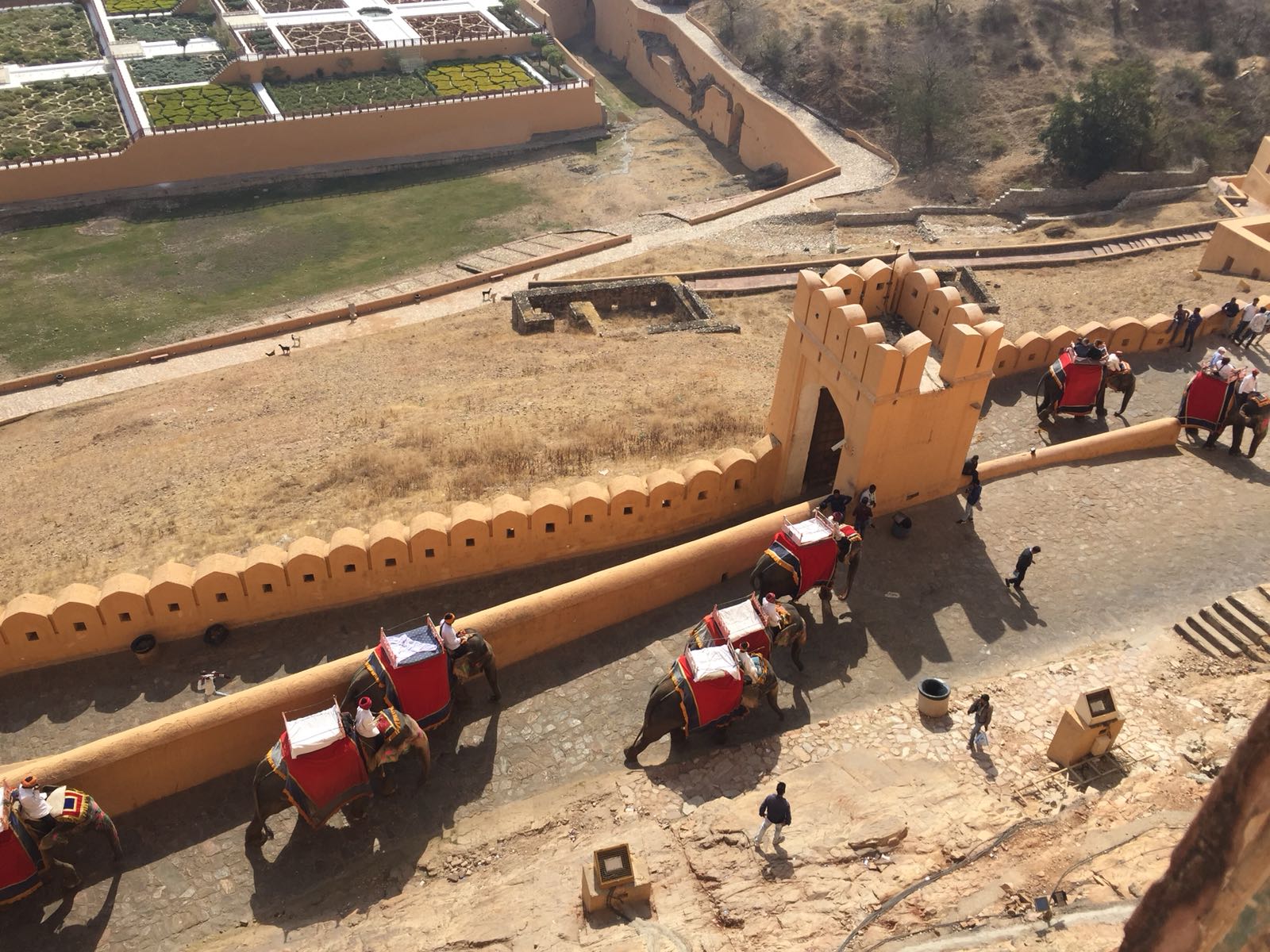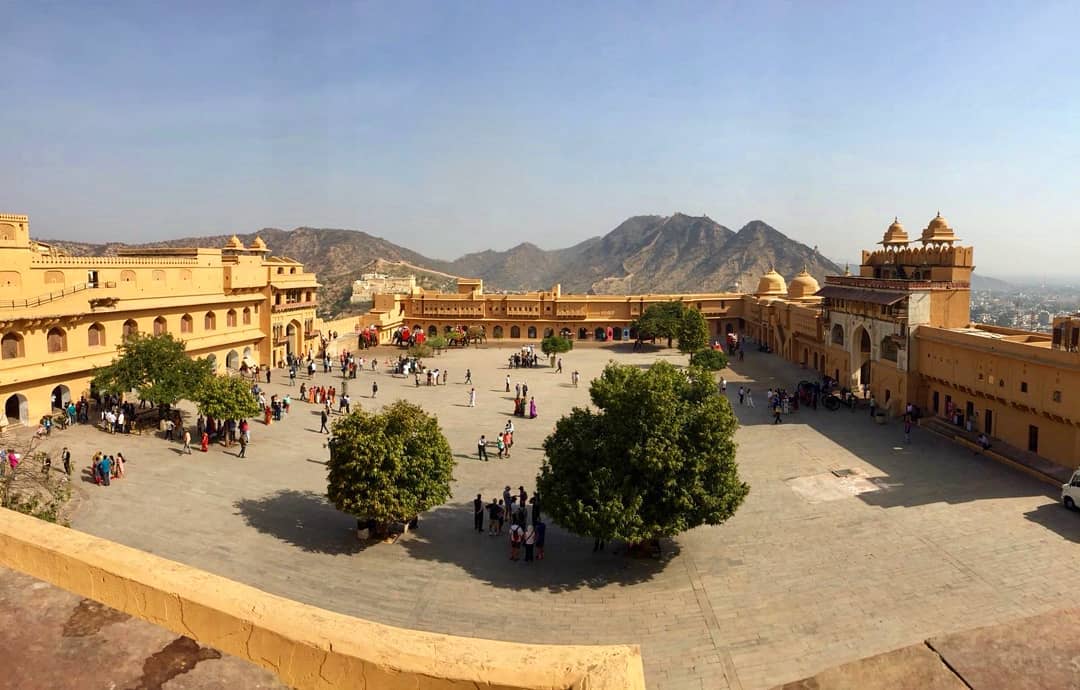Throughout the world, Global Heritage Fund works with communities and partners to save the world’s most endangered historic places. Nada Hosking, Director of Partners and Programs, and Katerina Acuna, Development Manager, recently visited our project sites in Rajasthan, India, and Patan, Nepal.
In this first part of a two-part series, Nada and Katerina joined Kuanghan Li, Director of the China Heritage Program, at Amer Fort. Their visit revealed the immense splendor of this sprawling palace and highlighted the need for sustainable site management.
Visitors to Amer Fort in Rajasthan, India, are oftentimes surprised by the sheer size and opulence of this expansive and heavily ornamented palace. Although the name may sound like a military site, Amer Fort is a palace of lavish courtyards, ornate royal residences, and lush gardens. Intricate glass and metalwork are interspersed among towering walls of sandstone and marble, enticing visitors to wander through immense hallways and thick fortress walls. Once home to local rulers, Amer Fort’s opulent style and pioneering, eclectic mix of architectural motifs earned it a spot on the UNESCO World Heritage Site list in 2013.
With history spanning hundreds of years, it is no surprise that Amer Fort’s management needs are complex and require careful balancing of stakeholder considerations. The Fort attracts a wide array of visitors, with over 1.8 million annual tourists and over 215,000 monthly tourists during its busiest periods. In response to these pressing visitor numbers, Global Heritage Fund recently supported the development of a management plan for this popular historic site.

Against the sunset, Amer Fort’s red sandstone construction burnishes in golden hues.
Throughout the world, many heritage sites require carefully designed management plans to balance conservation and popular appeal. As sites attract greater degrees of public attention, the subsequent increase in popularity oftentimes swells tourism and visitor numbers, straining site resources and causing damage. In the case of historic palaces and forts, even well intentioned visitors can cause unintentional damage, such as the wearing down of ancient stone steps by thousands of visitors’ feet.
At Amer Fort, the situation is even more complication, as not every visitor arrives merely on foot. Although the main courtyard is accessible by walking paths, elephants also carry visitors through the decorative entrances once reserved for royalty. After arriving in the main courtyard, visitors are greeted by a cacophonous scene: motorcycles weave through milling groups of tourists, eager local guides ply their knowledge, and artisans hawk their crafts. The activity is unending and reminiscent of crowded urban areas. GHF’s Katerina Acuna recalls the courtyard as closer to a city street than a historic palace: “It reminded me of a New York city street — or even New York plus!”

Visitors arrive on elephants to Amer Fort.
Amer Fort requires a management plan that can incorporate its history while adapting to modern needs and popular appeal. Working with the Rajasthan Government, Global Heritage Fund has supported the creation of a management plan to ensure that the Fort will remain accessible for future visitors. The management plan involved site surveys of the Fort and buffer, documentation and inventory of cultural resources, and field studies assessing visitor needs, building usage, and historic structures and landscape. To evaluate for effective and sustainable tourism practices, the plan also addressed practical aspects of the visitor experience, such as facilities and signage.
This comprehensive management plan will preserve Amer Fort for future visitors to experience the splendor of the palace in person, facilitating better understanding of the Fort’s history and significance. As with other historic sites through the globe, photographs and written descriptions may do some justice to the Fort, but actually experiencing the location firsthand provides unparalleled understanding to questions such as How does the site reflect its surroundings? How does it fit within its natural environment? How does the community use and experience the site?

Amer Fort’s courtyard bustles with activity.
Especially at Amer Fort, photographs and written testimony are barely sufficient to adequately capture the splendor and magnitude of the site. The opportunity to visit Amer Fort — to gaze at its royal residences, walk beneath its towering walls, and cross its expansive courtyards — reveals truths that are not apparent from mere photographs and text. Katerina agrees: “By visiting, you get more of a sense of how the spaces interact, much more understanding than just pictures alone. That taught me so much about how the architecture reinforced the social structure of the palace.”
We look forward to supporting the future management of this amazing palace complex and ensuring it remains protected and accessible for visitors in the future.
Stay tuned for the next part of this series, updating readers on the success of our recent #RestoreNepal campaign and conservation work at the Vishveshvara Temple in Patan.

